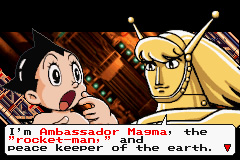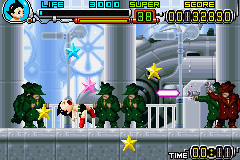Coming of age in wartime Japan, Osamu Tezuka found himself pulled from middle-school and pressed into service at an imperial arsenal. Standing lookout for American bombers in a watch tower, he survived a series of ferocious firebombings of his hometown, Osaka. He eventually went back to school and graduated with an M.D., but the memories of the bombings and his feelings on war and conflict never left him.
 He decided not to practice medicine and instead chose to give voice to his feelings through his true love, cartoons. Prolific is too small a word to use to describe his artistic output. With a body of work of more than 150,000 pages in hundreds of volumes he virtually defined the medium of manga in Japan for decades - with luminaries as well known as Hayao Miyazaki referring to Tezuka as a major influence.
He decided not to practice medicine and instead chose to give voice to his feelings through his true love, cartoons. Prolific is too small a word to use to describe his artistic output. With a body of work of more than 150,000 pages in hundreds of volumes he virtually defined the medium of manga in Japan for decades - with luminaries as well known as Hayao Miyazaki referring to Tezuka as a major influence.
Unlike other post-war cartoonists who sought to rectify feelings of loss and victimization at the hands of foreign aggressors, Tezuka often filled his works with themes of post-racial, post-national reconciliation and peace. One of this most globally regarded works is Astro Boy.
Ending print run in the late 60s, Astro Boy of course saw recreation as an anime series in the 1980s. Timed to hit at the same time as a new 2003 series, Astro Boy: The Omega Factor (AB:TOF) is a Game Boy Advance side-scrolling brawler with silky controls and a great sense of style that stays mostly true to the spirit of the original manga that has a few flaws that keep it from greatness.
Made by the legendary Treasure and Hitmaker (Sega AM3), AB:TOF is a bright and breezy game with lots of visual impact that shows off lots of what the GBA could do in the right hands. It features tons of recognizable Astro Boy characters, rendered in loving detail and a surprisingly long and possibly overly ambitious game for a portable experience.
While many reviews compare AB:TOF to the Mega Man series, I think this unnecessarily conflates two cute robot fighters for justice. There's really very little in common between the games. AB:TOF is also often called "action platformer", but there's very little platforming in the game in any traditional sense. Instead you're put in charge of a cute fighting mechanoid who jumps and flies around the screen with ease to punch and kick and laser and machine gun your enemies. Combos flow freely and special moves are wonderfully easy to pull off without any of complex Street Fighter/Tekken finger twisters. It's fun to pound your enemies and send them careening across the screen into each other. That fun factor kept me playing long after I had any reason to. In, fact I ended up playing through the entire game about 4 times I was having such a kick with the fluid controls.
In typical Treasure style, the game is loaded with bosses, sometimes bosses after bosses after bosses. In the context of a brawler this actually works pretty well and really turns the game into a boss rush game with filler levels full of fairly easy look-alike enemies. Not all the bosses are great, but the ones that are good are interesting and screen filling.
To mix things up there are also shooter levels. Astro Boy flies, Superman style, and fires a laser out of his finger. A variant of the shooter levels, Astro Boy assumes a vertical, slower, position, but can fire in both directions. These are pretty welcome diversions from the brawling and offer some surprising variety to the game. They aren't Gradius, but they're effective for what they do.
The music is upbeat, catchy and perfectly fits the game. I don't think I would make a big effort to listen to any of it outside of the context of the game, but it's actually kind of hard to think about AB:TOF without the great music. It perfectly complements the on screen action in almost every part of the game. I think the only place the music really suffers is the lousy sound production of the GBA (at least as compared to the SNES's glorious Sony produced SPC700).
So what keeps this game from greatness? In a word, polish. It feels like the developers set a scope far too ambitious for the development resources available -- the game was in serious need of some critical editing. By combining story lines from many of the manga issues they resulted in a huge, virtually unfollowable story involving time travel, international politics, doomsday machines, tragic loss, ancient lost civilizations and more, with far too much dialog for a brawler. It's too much, and it's not tied together. The late game suffers as well as it tries to accommodate this mess.
 After the first few overly long bits of talking, you'll find yourself just skipping through them. But of course this is a mistake as clues are embedded in the conversation that helps you solve the time-travel riddle the conclusion of the game hangs off of. You can get pretty far in the game ignoring this nonsense and have a more enjoyable time, even if the trade-off is that you probably won't be able to complete the game, destined to endless loop through time not knowing about the central conceit in the game.
After the first few overly long bits of talking, you'll find yourself just skipping through them. But of course this is a mistake as clues are embedded in the conversation that helps you solve the time-travel riddle the conclusion of the game hangs off of. You can get pretty far in the game ignoring this nonsense and have a more enjoyable time, even if the trade-off is that you probably won't be able to complete the game, destined to endless loop through time not knowing about the central conceit in the game.
The biggest problem I felt while playing was the feeling of sameness throughout the game, despite all the attempts at variety. I think this stems from the way the game sets up the fights: you'll run a bit, the screen will lock into a small "arena" and a wave of the same enemy will drop down out of the sky. You'll destroy all of the enemies then move on to the next "arena" and fight a slight variation of the enemy you just fought in the previous arena -- a different color, or maybe a different size. And you'll do this for a dozen times in a level, maybe broken up by a couple waves of a different enemy. In most brawlers, you might fight one kind of enemy, then another, then some combination of the two to make it interesting. AB:TOF is almost completely devoid of these combination battles and I think the non-boss portions of the game really suffers for it as non-boss fights start to drag on and on.
Another problem is the surprising amount of slowdown in the game. I can't ever really recall playing a GBA game with slowdown, but there are a number of moments with only 3 or 4 sprites on the screen at once and the frame rate drops terribly. It's weird, especially given Treasure's renown for manic gameplay with screens piled full of enemies. It feels like an optimization issue that would have been solved late in a normal development cycle. It might also be the reason for the lack of combination battles I talk about above.
Finally, the late game suffers from a really pointless time-travel puzzle based on obscure clues referencing one of a few dozen characters you might have met once in the game for a few lines of dialog. It's really not worth figuring out on your own because it'll involve a careful reading of miles of hard to follow dialog. If you want to see the game ending, it's best to just look up the solution someplace and follow it.
I think if the game had gone through a tight editing round early in development the game wouldn't have overreached so much and a bit more polish could have solved some of the issues in the game. It could have turned this from an okay B game into an A game. There's really lots to love here, so don't let these issues turn you off from the game -- it's a fun game that's totally worth a play through. Just don't get hung up on the story.



No comments:
Post a Comment